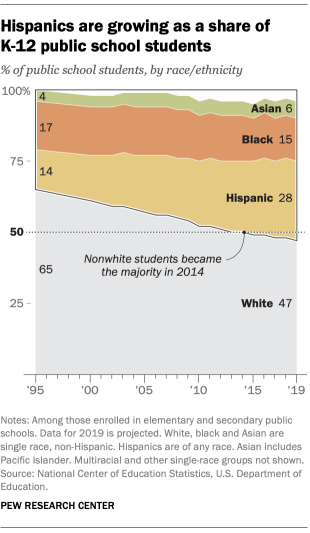A study released by The Pew Research Institute last week says “Nonwhites now account for the majority of the nation’s newborns, as well as the majority of K-12 students in public schools.”
The report goes on to say that “More than half of newborn babies in the U.S. are racial or ethnic minorities, a threshold first crossed in 2013. Nonwhite students also account for the majority of the nation’s K-12 public school students. As of fall 2018, children from racial and ethnic minority groups were projected to make up 52.9% of public K-12 students.”
It’s long been known that the numbers of the native white population of United States citizens was on the decline. The Hill reported in 2016 that the median age of white Americans was 43, while the number over 65-years-old jumped from 15 percent to 18 percent of the overall white population. In South Carolina whites represent about 67% of the population. Those Americans have since aged three more years. However, the average American Latino is 28-years-old and Latino birth rates exceed death rates in all 50 states.
The former President of the Raza Unida Party, or La Raza, José Ángel Gutiérrez, is an attorney and professor at the University of Texas at Arlington in the United States, he recognized long ago the changing demographics in America and has promoted advancing that decline. He was also a founding member of the Mexican American Youth Organization (MAYO) in San Antonio in 1967. Gutierrez is quoted as saying “We have an aging white America. They are not making babies. They are dying. It’s a matter of time. The explosion is in our population.” This was good news to Gutiérrez as he later said, “We have got to eliminate the gringo, and what I mean by that is if the worst comes to the worst, we have got to kill him.”
The Pew Research Center analysis of Census Bureau data says that today’s kindergartners offer a glimpse of tomorrow’s demographics. It further says the number of states where at least one-in-five public school kindergartners are Latino has more than doubled since 2000.
That research says that in 18 states and the District of Columbia, Latino children accounted for at least 20% of public school kindergarten students in 2017 (the most recent year available), up from eight states in 2000. However, only two states – Massachusetts and Nebraska – and the District of Columbia have joined this list since 2010, while one state (Idaho) dropped off.
At nearly 60 million, Hispanics are the nation’s largest racial or ethnic minority group. They make up at least 18% of the U.S. population and have dispersed across the country widely since the 1980’s. The states where at least one-in-five kindergartners are Hispanic include some with historically few Hispanics, such as Massachusetts, Nebraska and Washington.
According to research from the U.S. Department of Education, the number of K-12 public school students from racial and ethnic minority groups – including Hispanic, black and Asian Americans – has been higher than the white student population nationwide since 2014. In fall 2019, children from racial and ethnic minority groups are projected to make up 52.9% of public K-12 students. That’s a sharp increase from 1995, when minority groups accounted for just 35.2% of these students. The current U.S. population is just over 330 million.
Today’s newborns also offer a glimpse into the nation’s future demographics. In 2018, more than one-in-four of the nation’s newborns were Hispanic. By 2060, Hispanics are projected to make up 27% of the overall U.S. population, according to Census Bureau projections from 2017.
José Ángel Gutiérrez founded the political and racial group La Raza, The Race. He has advocated since the 1960’s for Hispanics to cross the U.S. border illegally and get active in retaking America for Mexico. This included “eliminating the gringo” and removing the white population by force. The current Census information shows that reduction in the white population is occurring.
More broadly, slightly more than half of all babies born in the United States today are a racial or ethnic minority, a threshold first crossed in 2015. Racial and ethnic minorities are expected to make up more than half of the total U.S. population in coming decades. They currently make up about 40% of the overall population, with the share projected to increase to 56% by 2060, according to Census Bureau projections. In 2018, there were five states – Hawaii, California, New Mexico, Texas and Nevada – plus the District of Columbia where minority groups made up more than half of the population.
In addition to a population change, language diversity in the United States has changed rapidly over the past four decades. The use of a language other than English at home increased 200 percent since 1980 and this increase was not evenly distributed among languages. Polish, German, and Italian actually have fewer speakers in today as compared to 1980. Other languages, such as Spanish (13%), Chinese, Tagalog, Vietnamese, and Russian, have had considerable increases in their use.
Data on the language spoken at home is from the American Community Survey and the U.S. Census Bureau’s National Population Projections. The survey projected what language will be spoken other than English in 2020. Based on these latest Census Bureau data Dorothy may not recognize Kansas anymore.
Michael Reed is Editor of The Standard.





 RSS - Posts
RSS - Posts
And why do we need afirmitive action anymore?!?